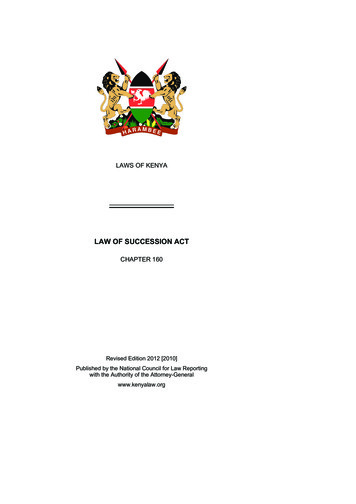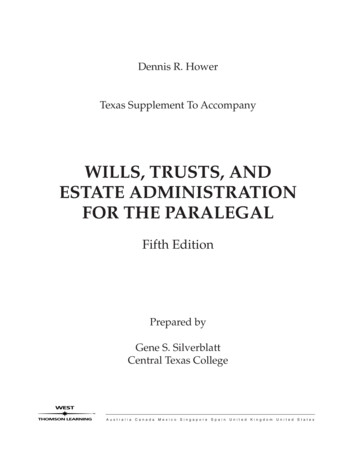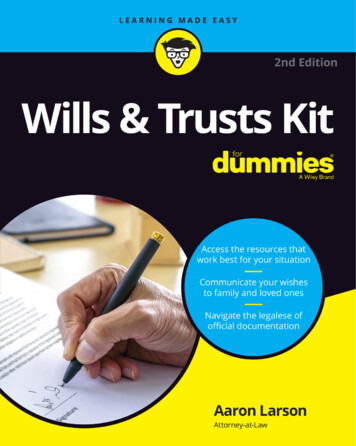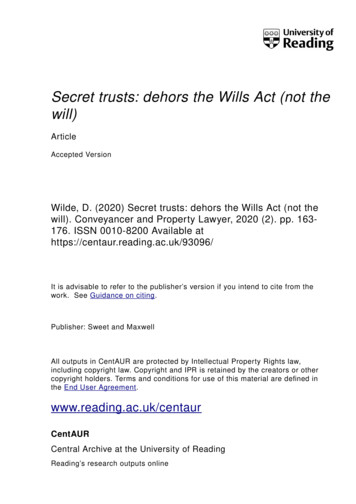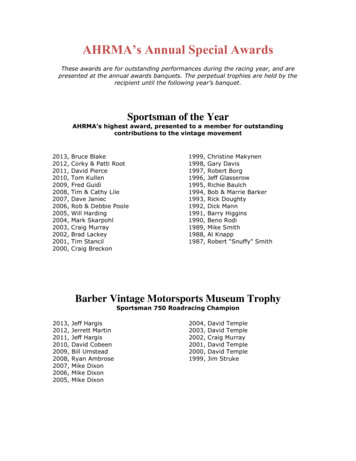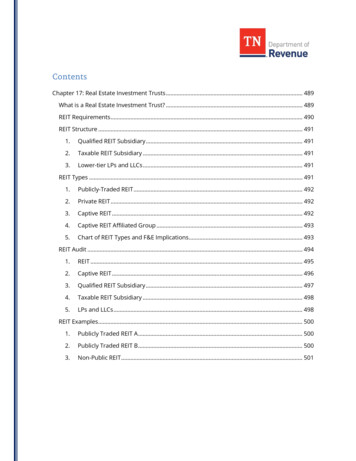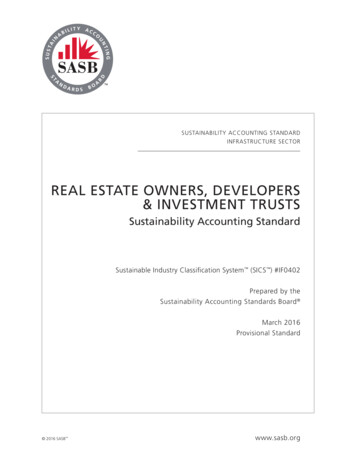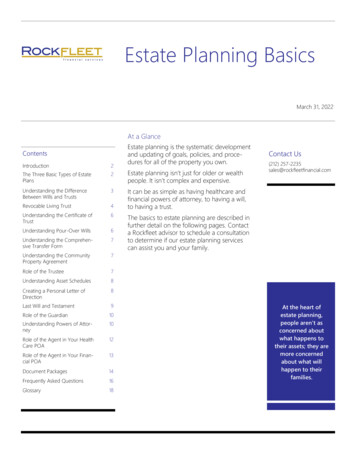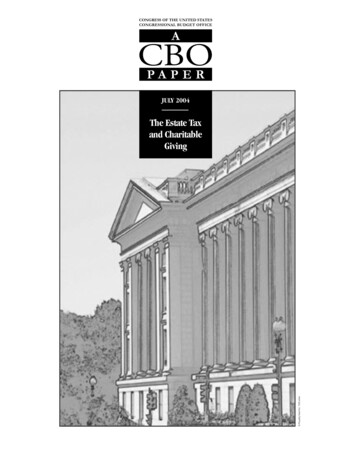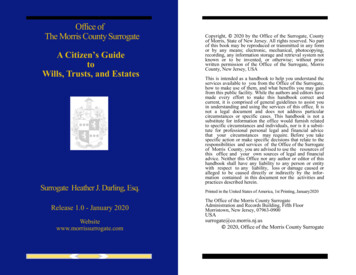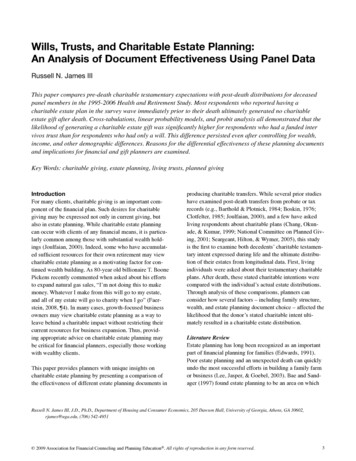
Transcription
Wills, Trusts, and Charitable Estate Planning:An Analysis of Document Effectiveness Using Panel DataRussell N. James IIIThis paper compares pre-death charitable testamentary expectations with post-death distributions for deceasedpanel members in the 1995-2006 Health and Retirement Study. Most respondents who reported having acharitable estate plan in the survey wave immediately prior to their death ultimately generated no charitableestate gift after death. Cross-tabulations, linear probability models, and probit analysis all demonstrated that thelikelihood of generating a charitable estate gift was significantly higher for respondents who had a funded intervivos trust than for respondents who had only a will. This difference persisted even after controlling for wealth,income, and other demographic differences. Reasons for the differential effectiveness of these planning documentsand implications for financial and gift planners are examined.Key Words: charitable giving, estate planning, living trusts, planned givingIntroductionFor many clients, charitable giving is an important component of the financial plan. Such desires for charitablegiving may be expressed not only in current giving, butalso in estate planning. While charitable estate planningcan occur with clients of any financial means, it is particularly common among those with substantial wealth holdings (Joulfaian, 2000). Indeed, some who have accumulated sufficient resources for their own retirement may viewcharitable estate planning as a motivating factor for continued wealth building. As 80-year old billionaire T. BoonePickens recently commented when asked about his effortsto expand natural gas sales, “I’m not doing this to makemoney. Whatever I make from this will go to my estate,and all of my estate will go to charity when I go” (Faerstein, 2008, ¶4). In many cases, growth-focused businessowners may view charitable estate planning as a way toleave behind a charitable impact without restricting theircurrent resources for business expansion. Thus, providing appropriate advice on charitable estate planning maybe critical for financial planners, especially those workingwith wealthy clients.This paper provides planners with unique insights oncharitable estate planning by presenting a comparison ofthe effectiveness of different estate planning documents inproducing charitable transfers. While several prior studieshave examined post-death transfers from probate or taxrecords (e.g., Barthold & Plotnick, 1984; Boskin, 1976;Clotfelter, 1985; Joulfaian, 2000), and a few have askedliving respondents about charitable plans (Chang, Okunade, & Kumar, 1999; National Committee on Planned Giving, 2001; Seargeant, Hilton, & Wymer, 2005), this studyis the first to examine both decedents’ charitable testamentary intent expressed during life and the ultimate distribution of their estates from longitudinal data. First, livingindividuals were asked about their testamentary charitableplans. After death, these stated charitable intentions werecompared with the individual’s actual estate distributions.Through analysis of these comparisons, planners canconsider how several factors – including family structure,wealth, and estate planning document choice – affected thelikelihood that the donor’s stated charitable intent ultimately resulted in a charitable estate distribution.Literature ReviewEstate planning has long been recognized as an importantpart of financial planning for families (Edwards, 1991).Poor estate planning and an unexpected death can quicklyundo the most successful efforts in building a family farmor business (Lee, Jasper, & Goebel, 2003). Bae and Sandager (1997) found estate planning to be an area on whichRussell N. James III, J.D., Ph.D., Department of Housing and Consumer Economics, 205 Dawson Hall, University of Georgia, Athens, GA 30602,rjames@uga.edu, (706) 542-4951 2009 Association for Financial Counseling and Planning Education . All rights of reproduction in any form reserved.
consumers commonly wanted financial planners to advisethem. In a study of the risk tolerance of business owners,Wang and Hanna (2007) suggested that for such clients,“comprehensive financial planning advice, includinginsurance and estate planning, may be more useful thanspecific advice about investment alternatives” (p. 16). Formany clients, successfully providing such comprehensivefinancial planning advice, including estate planning, willinvolve issues of planning charitable estate gifts.Much of the previous research on estate planning decisionshas focused on the family dynamics of intergenerationaltransfers or the determinants of having estate planningdocuments. The possession of estate planning documentshas generally been positively associated with greaterwealth, education, income, age, and white racial status(Goetting & Martin, 2001; Simon, Fellows, & Rau, 1982).Similarly, Su (2008) found that both financial and healthend-of-life documents were more common among thosewith greater wealth and education.Much research has focused on the family dynamics ofintergenerational transfers (Bernheim, Shteifer & Summers, 1985; Cox & Rank, 1992; Stum, 2001). For example, Stum (2001) examined the emotional and familydynamics of transferring personal property. Others haveconsidered the larger topic of intergenerational familytransfers as encompassing both testamentary and intervivos transfers (Cox & Rank, 1992; Hayhoe & Stevenson,2007; Koh & MacDonald, 2006). Although such family transfers constitute the bulk of testamentary transfers,charitable bequests are also economically significant.The practice of leaving a charitable gift in one’s estate planis by no means a strictly modern concept. Using a sampleof seventeenth century English wills, McGranahan (2000)found that about 25% of testators left a gift to “the poor,”usually for the benefit of those in the decedent’s homeparish. While charitable estate giving is nothing new, amore recent development has been the rise of the plannedgiving profession. Whether working for charitable organizations or serving as independent advisors to the charitablyinclined, planned giving professionals provide guidanceto clients in areas such as charitable estate planning. Asevidence of the importance of this field, the National Committee on Planned Giving (2008), a professional association of planned giving professionals, recently reported amembership of approximately 10,000.By any measure, charitable estate planning is economicallysignificant. Giving through bequests generates over 22billion annually for nonprofit organizations in the United States (Giving USA Foundation, 2007). By comparison, allcharitable gifts from businesses and corporations produceslightly more than half that amount (Giving USA Foundation, 2007). While charitable estate giving is alreadysubstantial, the aging of the population will likely producesignificant increases in such estate transfers in the coming years (Radcliff, 2002). Consequently, the importanceof planned giving advisors should continue to increase.This is particularly true for advisors in non-profit organizations, such as colleges and universities, that receive alarger than average share of gift income from charitablebequests. Although charitable bequests make up about 8%of total charitable giving (Giving USA Foundation, 2007),colleges and universities report that nearly one-quarter oftheir individual giving comes from bequests (Council forAid to Education, 2004).The size and potential of this area of financial advising issignificant, but planned giving presents a particularly challenging environment for research. Where current givingmatches the donor’s actions with an immediate receipt ofmoney by the charity, charitable estate planning is quitedifferent. A donor’s charitable estate planning may notresult in a gift for years, decades, or at all, depending onintervening plan changes and asset accumulation patterns.Estate planning advisors can develop plans, but it is rarefor an advisor to aid in both developing the original estateplan and administering the estate distribution after theclient has died. While tax or probate records show finaldistributions, it is difficult to measure document effectiveness because ineffective documents do not appear in thepublic record. Unprobated wills and unfunded trusts mayleave no evidentiary record behind.To this point, much investigation of charitable estategiving has been based upon post-mortem information oncompleted gifts from tax records and probate records orsurveys sent to charitable organizations. These studieshave commonly focused on the analysis of tax policy. Researchers have generally found that increased estate taxeshave resulted in increased charitable estate giving (Bakija& Gale, 2003; Boskin, 1976; Clotfelter, 1985; Joulfaian,1991, 2000; Kopczuk & Slemrod, 2003).Other post-mortem research in charitable estate planninghas indicated that both the existence and proportional shareof bequest giving is positively associated with wealth (Barthold & Plotnick, 1984; Boskin, 1976; Clotfelter, 1985;Joulfaian, 2000), although bequests to religious organizations appeared to be relatively wealth inelastic (Barthold& Plotnick, 1984). Findings regarding the association withJournal of Financial Counseling and Planning Volume 20, Issue 1 2009
marriage have been mixed. Using records from 1,020 largeConnecticut estates, Barthold and Plotnick (1984) foundthat the presence of a surviving spouse diminished the sizeof charitable bequests. However, McNees (1973), usingestate tax return data, found that widowhood (i.e., womenwith no surviving spouse due to husband’s death) wasassociated with significantly smaller charitable bequests,even after controlling for estate size.Although less common than post-mortem research, someresearch has employed survey data regarding the charitableestate plans of living donors. Both the National Surveyof Giving and Volunteering (Chang, Okunade, & Kumar,1999) and the National Committee on Planned Giving’s(2001) survey asked respondents about their charitable estate plans. Seargeant, Hilton and Wymer (2005) presentedresults from a study of living donors who had indicatedthey had named one of four charitable organizations in abequest. However, none of these studies were longitudinal,and thus none were able to connect the lifetime intentionsexpressed by current donors with actual estate distributionoutcomes. This paper is the first to connect lifetime charitable testamentary intentions expressed by individuals withlater post-mortem distributional outcomes.Other estate planning research using portions of the datasetanalyzed in this paper has examined the impact of estatetaxes on current giving (Greene & McClellan, 2001),bequests to children (Cox & Stark, 2005; McGarry, 1999),characteristics of those with wills (Goetting & Martin,2001), characteristics of those with advanced healthdirectives (Hopp, 2000), and the impact of life events onthe decision to execute a will or trust (Palmer, Bhargava,& Hong, 2006). Hurd and Smith (2001, 2002) comparedrespondents’ predictions regarding the anticipated size oftheir estates at death with the actual size of their post-mortem estates. They found that expectations of leaving anestate were greater for those who were wealthier and widowed. The likelihood of leaving any assets after death wasreduced by substantial out-of-pocket medical expenses.However, Hurd and Smith did not examine discrepanciesbetween actual and anticipated beneficiaries, charitablebequests, or estate planning document selection.Theoretical FrameworkUnlike the typical consumer transaction, the decision tomake a post-mortem transfer does not, by itself, enhancethe consumption of the testator. Some have modeledplanned bequests to children or relatives as a method togain current services from future beneficiaries (Bernheim, Shteifer & Summers, 1985). But, such a model willJournal of Financial Counseling and Planning Volume 20, Issue 1 2009not typically apply to a revocable charitable bequest, ascharities do not provide compensation for such revocablebequests. (Although some non-profits may provide publicrecognition for those reporting revocable planned gifts,this recognition usually results from self-report, and thereis no mechanism to prevent either false reports or immediate revocation.)As such, the motivation to provide a post-mortem gift tocharity seems most reasonably modeled as a case of interdependent utility. Interdependent utility simply means thata person’s utility is a function not only of that individual’sown consumption, but also of the consumption of someother individual or individuals. Becker (1974) developeda framework for interdependent utility by first modelinginterdependent utility within a family context, and thenextending the model to charitable beneficiaries. For thesimplest case, an altruistic individual, i, has a perfectly interdependent utility function with another person, j. Thus,person i receives utility as an outcome of both her ownconsumption, Ci, and the consumption of person j, represented as Ui(Ci, Cj) (Becker, 1976). However, in the morecomplex case, the level of utility interdependence can varyfrom person to person.Because a testamentary distribution is a planned futuretransfer, the testator’s direct utility from the plan will bea function of the testator’s utility interdependence withplanned recipients, his or her estate size, and expectedtime until death. A change in one of these factors wouldresult in a change in the current utility of the plannedfuture transfer. Written as an equation, the current utilityto person i of an anticipated testamentary distribution to jothers iswhere mt is the likelihood of dying during timeperiod t, with,δt is a time discount factor where δ 1,j represents individuals other than i,ej represents the utility function (empathy) resulting from the anticipated post-mortem increasedutility of person j,wtsj indicates the size of the estate transfer to personj, as a function of anticipated wealth (wt) and distribution share (sj), andytj indicates the income level of person j at time tprior to any bequest.
The following investigation focused on discrepanciesbetween lifetime charitable testamentary intentions expressed by individuals and later post-mortem distributionaloutcomes. In particular, the question was whether document selection (wills v. inter vivos trusts) was a significantfactor in determining this discrepancy. However, in orderto isolate the effects of the document selection itself, onemust attempt to separate the effect of the documents fromthe characteristics of individuals who select certain typesof documents.An individual with a high desire to see that his or hercharitable testamentary plans are fulfilled should be morewilling to take precautions to insure that this outcomeoccurs. For example, the person may take greater care thatdocuments are safe, that charitable beneficiaries know offuture transfers, and that potential executors/administrators/trustees are supportive of the charitable transfer. Ifthese precautionary actions are also associated with theselection of a particular type of estate planning document,this could lead to a false conclusion that the documentitself was driving the increased likelihood of charitabledistribution, rather than other actions stemming from theindividual’s underlying desire. In such a case, financialplanners may be mistaken to expect that by simply changing the estate planning document, the likelihood of anultimate charitable distribution will increase.It would, of course, be quite difficult to measure the levelof underlying desire for charitable transfer fulfillmentamong those who have indicated an intention to makea charitable bequest. However, it is possible to use theprevious explanatory model to control for factors that mayinfluence the level of utility from a charitable transfer.For example, greater wealth, wt, suggests larger bequestsand, hence, greater utility from those bequests (ceterisparibus). The presence of naturally competing beneficiaries with high utility interdependence, ej, such as childrenor a spouse, may suggest relatively less concern over theeventual fulfillment of a charitable bequest intention. Agreater expectation of mortality, mt, due to health concernsmay increase the expected utility of the future bequest byshortening the anticipated length of time until transfer. Bycontrolling for these potential determinants of bequest utility, the analysis moves closer to identifying the true effectof the estate planning document itself.Of course, other mechanisms besides the testator’s underlying strength of desire for a charitable bequest fulfillment can explain a discrepancy between a person indicating thepresence of a charitable provision in a will or trust and theactual post-mortem generation of a charitable gift. Theperson’s estate may have been insolvent, thus resultingin distributions only to creditors. As such, this providesyet another reason to control for respondent wealth in anyestimation of the effectiveness of estate planning documents. Second, the respondent may have been referring toa contingent or delayed charitable gift in his or her will ortrust. Such contingent or delayed gifts are most commonin the case of married decedents where the entire estategoes to the surviving spouse and the charitable gift takesplace at the death of the surviving spouse. Consequently,this situation provides another reason to control for maritalstatus as a common correlate of such contingent or delayedcharitable plans.There are also some mechanisms where the choice of estateplanning document itself could alter charitable outcomes.One mechanism could be potential heir malfeasancethrough document destruction. Heirs who would inherit inthe absence of an estate planning document stand to gainfinancially from the elimination of a charitable estate gift.As such, the destruction of any evidence of a charitableestate planning document may financially benefit suchheirs. However, removing evidence of a funded trust maybe more difficult, given that public records often show thetrust as holding legal title, through the trustee, to variousassets. The relative simplicity of will destruction could suggest a differential outcome based on document selection.A less nefarious mechanism could be the inadvertent lossof documents by the decedent. A funded trust document ismore likely to be used regularly, as a copy of some portionof the trust may need to be provided whenever assets aremoved into or out of a trust. In contrast, a will document isnever used during life, which could increase the likelihoodthat its location would be forgotten in the intervening years.Finally, there is the possibility that the charitable estatedocument generates no charitable estate gift due to assettitling. The likelihood of this occurrence might be expected to differ between wills and funded trusts. A fundedtrust, by definition, controls at least those assets owned bythe trust. A will, on the other hand, ultimately controls onlythose assets titled solely in the name of the decedent withno “transfer on death” beneficiaries. In many cases, allassets may be held in joint ownership or with designatedbeneficiaries resulting in a will that controls no assets.Journal of Financial Counseling and Planning Volume 20, Issue 1 2009
At least two additional mechanisms could cause a discrepancy between charitable estate provisions during life andcharitable distributions during death. However, neithercould be completely controlled for in this study. First, decedents may have made last minute changes to estate plansbetween the final interview and death. In addition, as withall survey-based research, respondents may give incorrector misleading answers. If, however, these behaviors didnot systematically vary with document choice, then theydid not act as confounders for the following analyses.When a panel member of the HRS died, an “exit interview” was attempted with someone knowledgeableabout the financial situation of the deceased, typically afamily member (Institute for Social Research, 2007). Theexit interview included a series of questions about thedistribution of the financial estate of the deceased panelmember, including whether any transfers were made tocharitable organizations. The following analyses pooledall qualifying exit interview observations from all yearsunder examination.The following analyses explored the possibility of differential post-mortem distributional results between charitable wills and charitable funded trusts and attempted toidentify the relative importance of the alternative predictedmechanisms that may have been responsible for generatingthese differences. These questions can be separated as follows. First, did document selection have a differential effect on charitable distribution outcomes? Second, to whatextent was this effect the result of socio-economic factorsassociated with document selection, particularly health,wealth and familial status, rather than document selectionitself? Third, to what extent was the effect of documentselection driven by the problem of post-mortem missingdocuments?ResultsDescriptive StatisticsThe sample presented in Table 1 was limited to decedentswho completed a survey in the panel wave immediatelyprior to their date of death. As shown in Table 1, since the1995 and 1996 waves, 6,640 such panel members havedied (the column 4 total plus the column 1 total). Only4.5% of these decedents had indicated in the most recentprevious survey wave that they had left a charitable estategift (the column 1 total divided by the sum of columns 1and 5 totals). This was roughly similar to the frequency ofcharitable estate plans reported by living respondents ingeneral. Between 1995 and 2006, the overall percentage ofliving respondents in the HRS indicating the presence of acharitable estate plan was 5.0%.Data Collection MethodThe following analyses used data from the 1995-2006Health and Retirement Study (HRS). The HRS is a panelstudy designed to represent the national population ofAmericans over the age of 50. Initially beginning as twoseparate panels, the original HRS and the Study of Assetand Health Dynamics among the Oldest Old (AHEAD)merged in 1998 along with two new cohorts to form asingle HRS panel. Panel members were interviewed every2 years. Thus, each respondent may have had several interviews, referred to as waves, over the course of the study.Overall, this combined panel study has included more than26,000 individuals.The following analyses specifically focused on thosepanel members who indicated the presence of a charitableestate plan in the interview wave immediately prior totheir death. During life, respondents who had indicated theexistence of a will or trust were asked, “Have you madeprovisions for any charities in your will or trust?” (Institutefor Social Research, 2005, p. 2562). For convenience, additional references in this paper to the HRS should be readto include both the HRS and its antecedent, AHEAD.Journal of Financial Counseling and Planning Volume 20, Issue 1 2009In Table 1, the column headings above the results reflectinformation gathered from the decedent in the survey waveimmediately prior to the decedent’s death. Decedents reporting a planned gift were those answering, “yes” to thequestion, “Have you made provisions for any charities inyour will or trust?” In this study, estate planning documents were separated into the two categories of wills andfunded inter vivos trusts. In order for an inter vivos trustto function differently than a will (or a testamentary trustcontained within a will), it typically must be funded duringthe decedent’s life. If an inter vivos trust was establishedduring life but not funded except through the post-deathoperation of a pour-over will, then it becomes largelyequivalent to a testamentary trust found in a will. The reporting of a funded inter vivos trust came in responseto the question, “Have you put any of your assets into atrust?” (Institute for Social Research, 2005, p. 2456). Respondents who indicated that they had not funded a trustbut who responded positively to the question, “Do youcurrently have a will that is written and witnessed?” werecategorized as reporting only a will (Institute for SocialResearch, 2005, p. 2553).
Table 1. Estates of Health and Retirement Study Panel Members Dying 1996-20061Estate outcome variablesAllTotal estates298Charitable estatesNo estate documents foundDistributed estatesCharitable distributed estates40.9%7.7%27544.4%Decedent reported plannedcharitable estate gift during life2Fundedtrustreportedduring life8056.3%**3.8%†7659.2%***3Only 3.4%42.0%58683.7%Decedent did not report plannedcharitable estate gift during life5Fundedtrustreportedduring life4407.5%**5.0%**4187.9%**67Only will No will/trustreported reported durduringing 3.2%**Note. Column 2 t-test compares those reporting a funded trust with those reporting only a will (among those reporting aplanned charitable estate gift during life). Column 5 t-test compares those reporting a funded trust with those reporting only awill (among those NOT reporting a planned charitable estate gift during life). Column 7 t-test compares those reporting neither a will or a trust with those reporting only a will (among those NOT reporting a planned charitable estate gift during life).nsp .10. †p .10. *p .05. **p .01.While the column headings in Table 1 reflect informationprovided by the decedent during life, the row labels indicate post-death information, typically provided by a surviving family member. A charitable estate in Table 1 wasone where the surviving family member or caretaker indicated that the decedent had made provisions in either thetrust or the will for charities or that any of the decedentspossessions were left to charities. Where the survivingfamily member indicated that the decedent had no will andhad funded no trust, the decedent was classified as havingno estate documents. A small proportion of the estates hadnot been distributed at the time of the surviving familymember’s interview. To examine the extent to which thismay have affected the outcome, the final two rows reporttotals only for those estates that had been distributed at thetime of the interview.The cross-tabulations in Table 1 show a noticeable difference between the charitable outcomes of those decedentsreporting only wills and those reporting a funded trust.Among those reporting a charitable estate gift in the surveywave immediately prior to death, about 35% of those having only a will generated a charitable estate gift, while 56%of those with a funded trust generated such a gift.One possible explanation for this difference in documentoutcomes could be the malfeasance of heirs who intentionally destroyed estate documents containing charitable pro- visions. Such destruction may be quite problematic whereproperty is already titled in the name of a trust, especiallyin jurisdictions where some provisions of a real estateowning trust must be recorded in the chain of title. Conversely, destruction of a will may present a much easieropportunity, leading directly to intestate succession. Columns 2 and 3 of Table 1 show that decedents who reportedhaving a funded trust were less likely to leave estateswhere no estate documents were found as compared withdecedents who reported having only a will. Among estatesof decedents who had indicated the presence of a charitable estate gift, the missing document problem occurred 5.4percentage points more frequently in wills (9.2%) than infunded trusts (3.8%). (This difference was significant onlyat the p .10 level.) However, the missing document problem does not explain the entire difference between willsand trusts. The overall difference in charitable distributionsbetween wills and trusts was 21 percentage points (56.3%–35.3%), far more than the 5.4 percentage point differencein missing estate documents.This situation may also reflect the greater care taken topreserve estate documents by decedents who have gonethrough the process of funding a trust. Further, the problemof missing estate documents was less common whendecedents had reported the presence of a charitable estategift than when they had not. (i.e., missing documents weremore frequent in column 5 than in column 2, and moreJournal of Financial Counseling and Planning Volume 20, Issue 1 2009
frequent in column 6 than in column 3). This suggestedthat charities were not particularly vulnerable to exclusionthrough document destruction.Another explanation for the relatively poor showing ofwills in delivering charitable gifts is that lengthy probateprocesses may have skewed the results. In other words,the charitable transfer may still have been forthcomingfor many wills when the survivor was interviewed. Toeliminate this source of bias, the final two rows reportresults only for those estates that had been distributed priorto the survivor interview. This approach barely affected theperformance gap between wills and trusts (i.e., column 3subtracted from column 2), changing it from 21.0 percentage points to 20.5 percentage points. Consequently, thelength of the probate process does not appear to have beendriving the difference in charitable results between willsand funded trusts.While the cross-tabulations indicated a dramatic differencebetween the outcomes of wills and trusts, a variety of reasons unrelated to the planning vehicles themselves couldhave caused this difference. For example, it may have beenthat respondents’ wealth was driving both the charitableoutcome and the choice of estate planning vehicles. Simi-larly, to the extent that married couples were more likely tohave wills instead of funded trusts, this marital differencecould have skew
Wills, Trusts, and Charitable Estate Planning: An Analysis of Document Effectiveness Using Panel Data Russell N. James III This paper compares pre-death charitable testamentary expectations with post-death distributions for deceased panel members in the 1995-2006 Health and Retirement Study. Most respondents who reported having a

